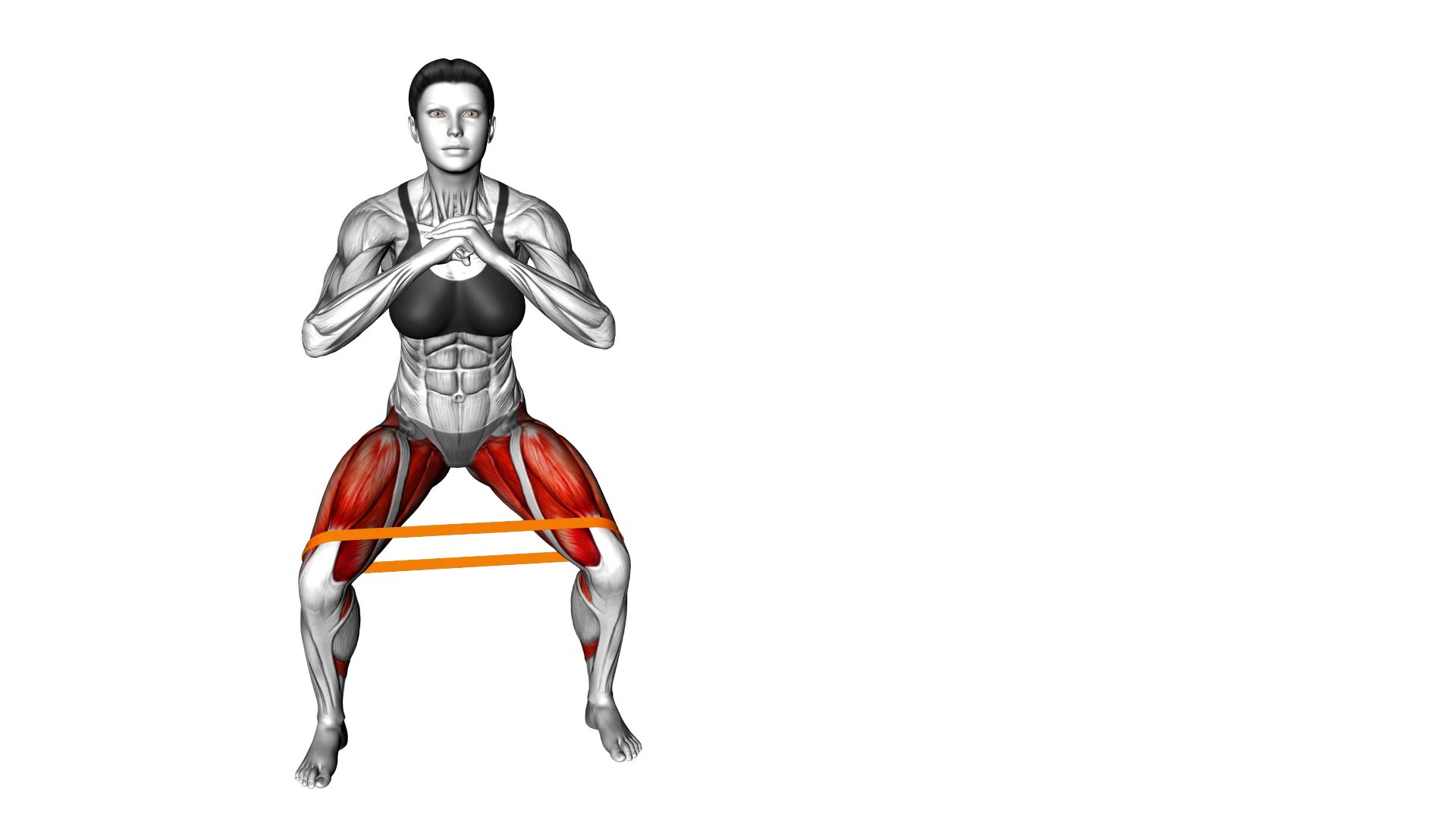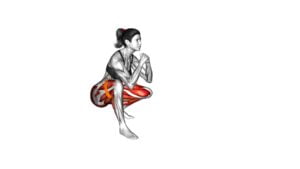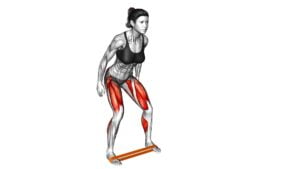Resistance Band Side Walk Squat (female) – Video Exercise Guide & Tips

Get ready to tone and strengthen your lower body with the resistance band side walk squat. This video exercise guide and tips will show you the proper form and technique, as well as variations to challenge yourself.
Watch This Exercise Video
Avoid common mistakes and maximize your results with these helpful tips.
Let's get started on your fitness journey!
Key Takeaways
- Resistance band side walk squats improve lower body strength and stability.
- The exercise targets the glutes, quadriceps, hamstrings, and calves.
- It tones and strengthens muscles, while also building endurance.
- To maximize results, choose the right resistance band, engage core muscles, focus on breathing and maintain control during the exercise.
Benefits of Resistance Band Side Walk Squat
The benefits of the resistance band side walk squat include improved lower body strength and stability. This exercise targets the muscles in your glutes, quadriceps, hamstrings, and calves, helping to tone and strengthen them. The resistance band adds an extra challenge to the exercise, making it more effective in building muscle and increasing endurance.
There are different types of resistance bands that can be used for this exercise, such as loop bands or tube bands with handles. The choice of band depends on your preference and fitness level. In addition to the resistance band, you'll also need a flat surface to perform the side walk squat.
By incorporating the resistance band side walk squat into your workout routine, you can expect to see improvements in your lower body strength and stability. This exercise activates multiple muscle groups, helping to build lean muscle and improve overall balance. It can also be beneficial for athletes looking to enhance their performance in sports that require lower body strength and stability, such as running, jumping, and change of direction movements.
Now that you understand the benefits of the resistance band side walk squat, let's move on to discussing proper form and technique to ensure you get the most out of this exercise.
Proper Form and Technique
To perform the resistance band side walk squat with proper form and technique, you need to maintain a stable lower body position while engaging your glutes and thighs. This exercise not only targets your lower body muscles but also improves your overall stability and balance. The benefits of proper form and correct technique are numerous.
Maintaining a stable lower body position is crucial for this exercise. Keep your feet shoulder-width apart and your knees slightly bent. Engage your core muscles to stabilize your torso. Place the resistance band around your thighs, just above your knees. This will add resistance and challenge your muscles further.
To perform the side walk squat, step sideways with one foot while keeping tension on the resistance band. Bend your knees and lower your body into a squat position. Make sure to keep your knees in line with your toes and your back straight. Push through your heels to return to the starting position and repeat on the other side.
Variations to Challenge Yourself
To challenge yourself with the resistance band side walk squat, try incorporating variations into your workout routine. These progression options can help you increase the difficulty of the exercise and further activate your muscles.
One variation to try is increasing the resistance of the band. This can be done by using a band with higher tension or by using multiple bands at once.
Another option is to add a pulse at the bottom of the squat. This involves lowering yourself into the squat position and then pulsing up and down slightly before coming back up.
You can also try incorporating a hop into the exercise. Instead of simply stepping to the side, add a small jump in between each step. This will increase the intensity and challenge your balance and coordination.
By incorporating these variations, you can continue to challenge yourself and see further improvements in strength and muscle activation.
Now, let's move on to discussing the common mistakes to avoid when performing the resistance band side walk squat.
Common Mistakes to Avoid
One common mistake to avoid when performing the resistance band side walk squat is neglecting proper form. Proper form is crucial to ensure that you're targeting the correct muscle groups and preventing injury. Here are three common mistakes to avoid when performing this exercise:
- Allowing your knees to cave in: When performing the side walk squat, it's important to keep your knees aligned with your toes. Allowing your knees to cave in puts unnecessary strain on your joints and can lead to discomfort or injury.
- Leaning too far forward: It's important to maintain an upright posture throughout the exercise. Leaning too far forward not only reduces the effectiveness of the exercise, but it also puts strain on your lower back.
- Not engaging your core: Your core plays a crucial role in stabilizing your body during the resistance band side walk squat. Failing to engage your core can lead to poor balance and make it more difficult to maintain proper form.
By avoiding these common mistakes and focusing on proper form, you can maximize the benefits of the resistance band side walk squat and minimize the risk of injury.
Now, let's move on to the next section where we'll discuss tips for maximizing your results.
Tips for Maximizing Results
To maximize your results with the resistance band side walk squat, focus on maintaining proper form and incorporating these tips.
First, make sure you choose the right resistance band for your fitness level. Using a band that's too easy or too difficult can limit your gains.
Next, engage your core throughout the entire exercise. This won't only help you maintain balance but also increase the intensity of the workout.
Additionally, pay attention to your breathing. Inhale as you lower into the squat and exhale as you push back up. This will help you maintain control and maximize your gains.
Another tip for maximizing results is to focus on your range of motion. Make sure you squat as low as you can while keeping proper form. This will engage your glutes, quads, and hamstrings more effectively.
Additionally, try to perform the exercise slowly and with control. This will increase the time under tension and enhance the efficiency of your workout.
Lastly, don't forget to rest and recover. Giving your muscles time to repair and rebuild is crucial for maximizing gains. Aim for at least one day of rest between resistance band side walk squat sessions.
Frequently Asked Questions
How Long Should I Do the Resistance Band Side Walk Squat Exercise to See Results?
To see results from the resistance band side walk squat exercise, you need to do it consistently and for an appropriate amount of time. The benefits of this exercise include strengthening your glutes, hips, and thighs while improving your stability and balance.
Aim to perform the resistance band side walk squat exercise for at least 15 to 20 minutes, three to four times a week. Remember to gradually increase the intensity and duration as you get stronger.
Can Resistance Band Side Walk Squat Help in Reducing Cellulite?
Resistance band side walk squat can be effective in reducing cellulite. By targeting the glutes, thighs, and hips, this exercise helps tone and strengthen these areas, which can help reduce the appearance of cellulite.
Incorporating resistance bands adds extra resistance, making the exercise more challenging and increasing muscle activation.
Consistency is key, so aim to do this exercise at least 2-3 times a week for optimal results.
Remember to combine it with a balanced diet and overall fitness routine for the best cellulite reduction.
Is It Safe to Perform the Resistance Band Side Walk Squat Exercise if I Have Knee Pain?
If you have knee pain, it's important to consult with a healthcare professional before performing the resistance band side walk squat exercise. They can provide guidance on modifications or alternative exercises that are safe for your condition.
While the resistance band side walk squat can be beneficial for strengthening the lower body and improving balance, it's crucial to prioritize your safety and well-being.
Always listen to your body and make adjustments as needed.
Can Resistance Band Side Walk Squat Help in Strengthening the Core Muscles?
Resistance band side walk squat is an effective exercise for strengthening your core muscles. By using resistance bands, you increase the intensity and challenge your muscles even more.
This exercise targets your glutes, quads, and hamstrings, while also engaging your core to maintain stability.
To perform it correctly, stand with your feet shoulder-width apart, place the resistance band above your knees, and squat down while taking small steps sideways.
Keep your back straight and core engaged throughout the movement for maximum benefits.
Can Resistance Band Side Walk Squat Be Modified for Beginners?
Resistance band modifications can be made to the side walk squat to make it more beginner-friendly. By using a lighter resistance band or even starting without one, you can gradually build up strength and stability in your legs and core.
The benefits of side walk squats include strengthening the glute muscles, improving hip mobility, and enhancing overall lower body strength.
It's important to focus on proper form and start with a comfortable range of motion to avoid injury.
Conclusion
Resistance band side walk squats are a great exercise for women to strengthen their lower body and improve overall fitness. By using proper form and technique, and incorporating variations to challenge yourself, you can maximize the benefits of this exercise.
Avoid common mistakes and follow the tips provided to ensure optimal results. Incorporate resistance band side walk squats into your workout routine to see improvements in strength, stability, and muscle tone.

Author
Years ago, the spark of my life’s passion ignited in my mind the moment I stepped into the local gym for the first time. The inaugural bead of perspiration, the initial endeavor, the very first surge of endorphins, and a sense of pride that washed over me post-workout marked the beginning of my deep-seated interest in strength sports, fitness, and sports nutrition. This very curiosity blossomed rapidly into a profound fascination, propelling me to earn a Master’s degree in Physical Education from the Academy of Physical Education in Krakow, followed by a Sports Manager diploma from the Jagiellonian University. My journey of growth led me to gain more specialized qualifications, such as being a certified personal trainer with a focus on sports dietetics, a lifeguard, and an instructor for wellness and corrective gymnastics. Theoretical knowledge paired seamlessly with practical experience, reinforcing my belief that the transformation of individuals under my guidance was also a reflection of my personal growth. This belief holds true even today. Each day, I strive to push the boundaries and explore new realms. These realms gently elevate me to greater heights. The unique combination of passion for my field and the continuous quest for growth fuels my drive to break new ground.







